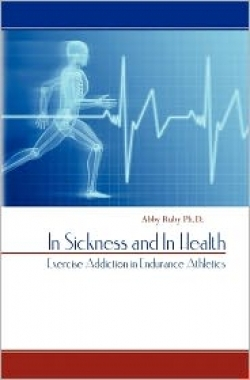In Sickness and In Health
Exercise Addiction in Endurance Athletics
“The dog is no longer wagging the tail, the tail is wagging the dog,” writes Abby Ruby, author of In Sickness and In Health: Exercise Addiction in Endurance Athletics. Exercise addiction, she continues, is a condition in which athletes “refuse to rest, become agitated during periods of taper, or prioritize training over family, work, and social obligations.” Based on her research with endurance athletes, Ruby concludes that it is not the level of training, but an athlete’s attitude toward exercise that determines whether or not he or she is addicted to exercise.
As a senior coach for Carmichael Training Systems and a USA Triathlon Level II coach with an interdisciplinary doctorate in psychology, sports studies, anthropology, and gender studies, the author speaks with authority. She is certified in sport nutrition, athletic training, and yoga, and placed first in the Ironman Brazil triathlon in the women’s age 19-24 division. Equally relevant, Ruby is a self-proclaimed exercise addict.
In Sickness and In Health emerged from the author’s research on her disorder. Its stated purpose is to serve as a resource for mental health practitioners, coaches, and athletes. However, its format and language often are inappropriate for the author’s intended audience. Ruby warns readers that they must “wade through” a hefty literature review of post-modern feminist sport before turning to practical matters. Indeed, nearly fifty percent of the book is rife with such passages as this: “Women’s participation in sport is a gender-transgressive behavior, but…is not necessarily agentic when one does so for the purposes of achieving a specific social aesthetic.” This is language for readers of academic journals, not for coaches, counselors, and athletes.
Ruby’s research found that the Exercise Dependence Questionnaire (EDQ) reliably differentiated between individuals who were and were not exercise dependent. This finding alone makes her work valuable. In addition, instructive snippets from the author’s interviews with Ironman triathletes provide interest, although readers must work to locate these gems buried within descriptions of quantitative and qualitative methodology more appropriate for academicians than sports enthusiasts.
In the final three chapters, In Sickness and In Health is at its most readable. Ruby provides symptoms of exercise addiction, tips for preventing over-training, and strategies for coping with days off from training.
Clearly, Ruby is sincere in her desire to diagnose and treat exercise addiction. But it is “infinitely easier to write about these issues than to embody and enact the solutions,” she concedes. “As I finish up this book, I do so with my arm in a sling, two broken bones in my shoulder, and three staples in my head”—injuries sustained in a cycling accident. Finally, Ruby must follow her own advice, but only because her damaged body requires her to do so. Such is the nature of exercise addiction.
Reviewed by
Nancy Walker
Disclosure: This article is not an endorsement, but a review. The publisher of this book provided free copies of the book and paid a small fee to have their book reviewed by a professional reviewer. Foreword Reviews and Clarion Reviews make no guarantee that the publisher will receive a positive review. Foreword Magazine, Inc. is disclosing this in accordance with the Federal Trade Commission’s 16 CFR, Part 255.

